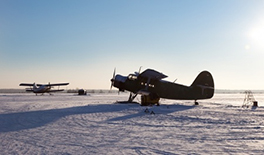| |
Home > Newsletter > Winterizing Aircraft for Storage or Flying, December 2020
Winterizing Aircraft for Storage or Flying
 According to a recent article in Business Aviation Digest, “Jets need maintenance, whether flying or not.” From Palm Beach to Allentown, and from Malaysia to Bavaria, there's a worldwide expansion of jet maintenance and improvement facilities. According to a recent article in Business Aviation Digest, “Jets need maintenance, whether flying or not.” From Palm Beach to Allentown, and from Malaysia to Bavaria, there's a worldwide expansion of jet maintenance and improvement facilities.
Jets across the globe are spending less time in the air, so owners and operators are taking advantage of this time to do maintenance, while in more normal times they would have otherwise waited. Some of the plans to expand were in the works before the pandemic, but many are in response to it.
Whether or not you’ve been flying less throughout the year, a complete winter maintenance is critical as the temperature drops to ensure the safety of all those on board, and to prolong the life of your aircraft. To help you get your plane prepped for cold weather, here's a checklist of some important things to do before putting up your plane for the winter.
- Reread the aircraft flight manual, particularly the sections on winterization.
- Keep the aircraft in a hangar, especially the night before a flight, if possible. If not, make sure the plane is covered.
- Make sure that the plane’s anti-icing, or deicing systems are operational.
- Change the engine oil to multi-grade, or the manufacturer-approved cold-temperature oil.
- Install a winterization kit to deflect the cold air and keep the cylinders warm.
- Renew the carbon monoxide detector and have the system checked for cracks.
- Turn on the cabin heater, heated pitot and demister to make sure they work.
- Make sure pitot head covers, static vent plugs, control surface locks and tie-downs are in working order.
- Confirm drain holes are clear of dirt and debris to prevent standing water from freezing and causing blockages.
- Check the carb heat and alternate air inlet, especially before takeoff.
- Find out if your aircraft requires isopropyl alcohol in the fuel for operation in low temperatures.
- After refueling, let the fuel settle in the tanks, then check for water in the system.
- Check that all the airframe, propeller and windscreen systems are operating correctly.
- Check that inflatable boots inflate properly, especially on the tailplane.
- Check that the battery is fully charged, and the alternator is working properly.
- Clean the airframe of mud, slush and dirt to prevent buildup in wheel pants and elevator hinges.
- On flight day, wear warm clothing and waterproof footwear.
- Pack a cold-weather parka, heavy blanket and winter survival kit on the plane.
- Before takeoff, get an up-to-date aviation weather forecast and note any icing warnings.
- Make sure your route plan is accurate and you have an alternative in case you encounter ice and snow.
Need help winterizing?
Whether your small aircraft needs winterizing, maintenance or full-service repair, Business Aircraft Center’s service crew will deliver fast, dependable service to get your airplane flying safely. To learn more about the quality service, call BAC at (203) 748-7000, and visit our services page.
Which companies are expanding their maintenance facilities and where are they located?
Read “Jets Need Maintenance Whether Flying or Not,” courtesy of Business Aviation Digest here.
back top |
|

 According to a recent article in Business Aviation Digest, “Jets need maintenance, whether flying or not.” From Palm Beach to Allentown, and from Malaysia to Bavaria, there's a worldwide expansion of jet maintenance and improvement facilities.
According to a recent article in Business Aviation Digest, “Jets need maintenance, whether flying or not.” From Palm Beach to Allentown, and from Malaysia to Bavaria, there's a worldwide expansion of jet maintenance and improvement facilities. 